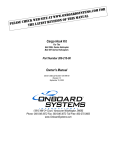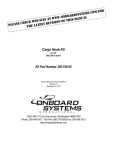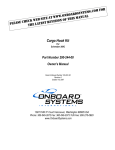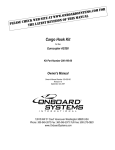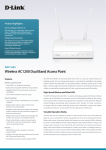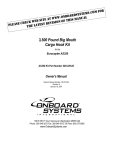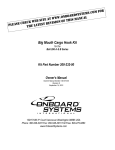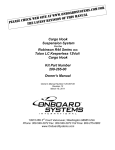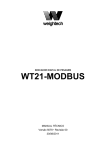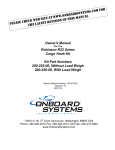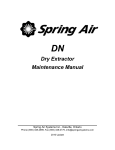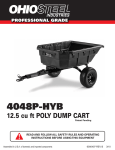Download 120-047-00 - Onboard Systems International
Transcript
Owner's Manual Cargo Hook Kit for the MD Helicopter’s 369 Series and 500N Helicopters Part Number 200-187-00 Owner's Manual Number 120-047-00 Revision 12 April 29, 2008 13915 N. W. 3rd Court Vancouver Washington 98685 USA Phone: 360-546-3072 Fax: 360-546-3073 Toll Free: 800-275-0883 www.OnboardSystems.com This page intentionally left blank. RECORD OF REVISIONS Revision Date Page(s) 5 10-10-00 Section 4 Reason for Revision Removed overhaul instructions from Section 4 and moved information to the new Service Manual 122001-00 3-5 6 5-31-01 RFMS Pg. 5 Replaced old hook no. 528-010-00 with current rev. 2-1, 2-4 7 9/11/02 Title, 4-3 Factory address change. 8 9/26/05 2-3, 2-5, Section 4 Clarified manual release cable rigging instructions, added CAUTION note for electrical connector, added kg equivalents to Table 2-1. Added reference to Cargo Hook Service Manual 122-001-00 in Section 4 and removed duplicate information from this manual. 9 02/07/07 1-1, 2-2, 31, 4-1 Changed cargo hook part number from 528-010-00 to 528-010-04 per Service Bulletin 159-017-00. Added reference to service manual on page 3-1 and removed reference to troubleshooting table. 10 09/12/07 Sections 1, 2, and 3 Listed RFMS 121-043-00 in Bill of Materials, removed RFMS from back of manual. Added “Warnings, Cautions, and Notes” section and reformatted these items where applicable. Updated Figure 2-3. 11 02/21/08 Page 1-1 Removed MD Helicopter kit p/n 369H90072-503 from the list of approved installations. 12 04/29/08 Page 1-1 Clarified part numbers and applicability in Introduction section. Register Your Products for Automatic Notifications Onboard Systems offers a free notification service via fax or email for product alerts and documentation updates. By registering your Onboard Systems products at our website, we will be able to contact you if a service bulletin is issued, or if the documentation is updated. You can choose to receive notices on an immediate, weekly, or monthly schedule via fax, email or both methods. There is no charge for this service. Please visit our website at www.onboardsystems.com/notify.php to get started. This page intentionally left blank. CONTENTS Section 1 General Information Introduction, 1-1 Warnings, Cautions, and Notes, 1-1 Bill of Materials, 1-2 Inspection, 1-2 Specifications, 1-2 Theory of Operation, 1-3 Section 2 Installation Instructions Cargo Hook Removal, 2-1 Cargo Hook Installation, 2-1 Secure the Release Cables, 2-4 Installation Overview, 2-4 Installation Check-Out, 2-5 Component Weights, 2-5 Paper Work, 2-5 Section 3 Operation Instructions Operating Procedures, 3-1 Cargo Hook Rigging, 3-2 Cargo Hook Rigging Illustrations, 3-3 Section 4 Maintenance Inspection, 4-1 Instructions for Returning a System to the Factory, 4-2 Section 5 Certification STC, 5-1 STA, 5-3 EASA STC, 5-5 i CONTENTS, continued Figures 2-1 2-2 2-3 2-4 2-5 2-6 3-1 3-2 3-3 3-4 3-5 Travel Limit Bumper Installation, 2-1 Attach Hardware Installation, 2-2 Bumper Pads, 2-2 Manual Release Cable Rig, 2-3 Un-commanded Release From Incorrectly Secured Cable, 2-4 Installation Overview, 2-4 Examples of Correct and Incorrect Cargo Hook Rigging, 3-3 Un-commanded Release Due to Large Load Ring, 3-4 Load Hang-Up, Too Small or Multiple Load Rings, 3-5 Un-Commanded Release Due to Nylon Straps, 3-6 Un-Commanded Release Due to Cable or Rope Straps, 3-7 1-1 2-1 4-1 Specifications, 1-2 Component Weights, 2-5 Inspection, 4-1 Tables ii Section 1 General Information Introduction The 200-187-00 cargo hook kit is approved for installation with the following MD Helicopters’ cargo hook kits which use the 369H92105-501 cargo hook assembly. 369H90072-501 369H90072-505 369H90072-507 369H90072-511 369H90072-515 369H90072-517 369H90072-519 369H90072-523 The 528-010-04 Cargo Hook, 270-073-00 Electrical Release Cable, and 268-005-01 Manual Release Cable included in this 200-187-00 cargo hook kit are suitable as replacements for the cargo hook (Breeze-Eastern P/N 17149-4), electrical release cable, and manual release cable in the MD Helicopters’ 369H92105-501 cargo hook assembly. Warnings, Cautions and Notes The following definitions apply to Warnings, Cautions and Notes used in this manual. Means that if this information is not observed, serious injury, death or immediate loss of flight safety could occur. Means that there is a risk of injury or degradation in performance of equipment if this information is not observed. Draws the reader’s attention to information which may not be directly related to safety, but which is important or unusual. General Information 1-1 Bill of Materials The following items are included with the Cargo Hook Kit, if shortages are found contact the company from whom the system was purchased. Part Number 528-010-04 270-073-00 268-005-01 290-360-01 290-361-00 120-047-00 121-043-00 122-001-00 Description Cargo Hook Electrical Release Cable Manual Release Cable Travel Limit Bumper Bumper Pads Owner’s Manual RFMS Talon LC Hook Service Manual Quantity 1 1 1 1 2 1 1 1 Inspection Inspect the kit items for evidence of damage, corrosion and security of lock wire and fasteners. If damage is evident, do not use the items until they are repaired. Specifications Table 1-1 Specifications Design load Design ultimate strength Electrical release capacity Mechanical release capacity Force required for mechanical release at 3,500 lb. Electrical requirements Minimum release load Unit weight Mating electrical connector 1-2 3,500 lb. (1,587 kg.) 15,750 lb. (7,142 kg.) 8,750 lb. (3,968 kg.) 8,750 lb. (3,968 kg.) 8 lb. Max.(.400” travel) 22-28 VDC 9 amps 7 pounds 3 pounds (1.36 kg.) PC06A8-2S SR General Information Theory of Operation The primary elements of the Cargo Hook are the load beam, the internal mechanism, and a DC solenoid. The load beam supports the load and is latched through the internal mechanism. The DC solenoid and an external manual release cable provide the means for unlatching the load beam. The load beam is normally returned to its closed position after release of the load by a spring in the internal mechanism. In the closed position, a latch engages the load beam and latches it in this position. The load is attached to the load beam by passing the cargo sling ring into the throat of the load beam past a spring-loaded keeper, which secures the load. To release the load, the latch is disengaged from the load beam. With the latch disengaged, the weight of the load causes the load beam to swing to its open position, and the cargo sling slides off the load beam. A spring in the internal mechanism then drives the load beam back to its closed and latched position. A load release can be initiated by three different methods. Normal release is achieved by pilot actuation of the push-button switch in the cockpit. When the push-button switch is pressed, it energizes the DC solenoid in the Cargo Hook, and the solenoid opens the latch in the internal mechanism. In an emergency, release can be achieved by operating a mechanical release lever. A manual release cable attached to the lever operates the internal mechanism of the Cargo Hook to unlatch the load beam. The load can also be released by the actuation of a lever located on the side of the cargo hook. General Information 1-3 This page intentionally left blank. Section 2 Installation Instructions These procedures are provided for the benefit of experienced aircraft maintenance facilities capable of carrying out the procedures. They must not be attempted by those lacking the necessary expertise. Cargo Hook Removal Remove the MD Helicopters’ supplied Cargo Hook from the aircraft by disconnecting the electrical release cable from the belly mounted bulkhead type connector. Disconnect the manual release cable from the cyclic stick release lever assembly and attaching clamps. Remove the single bolt used to attach the Cargo Hook to the airframe-mounting bracket and separate the Cargo Hook from the aircraft. Cargo Hook Installation Verify that the part number of the cargo hook removed is a Breeze-Eastern 2A20B P/N 17149-4. If it is not, do not attempt to use the new cargo hook unless compatibility is determined. Inspect the airframe to cargo hook mounting bracket and its hardware to ensure that all components are in serviceable condition. Install the P/N 290-360-01 travel limit bumper to the Cargo Hook as illustrated in Figure 2-1. The Travel Limit Bumper helps protect the aircraft skin and the release cables from excessive hook movement. Do not use the hook without the travel limit bumper in place. Figure 2-1 Travel Limit Bumper Installation TRAVEL LIMIT BUMPER CORRECTLY INSTALLED TRAVEL LIMIT BUMPER INCORRECTLY INSTALLED Install the new Cargo Hook to the existing MDHC airframe mounting bracket using the load bolt, nut and cotter pin supplied with the new hook, as illustrated in Figure 2-2. The cargo hook load beam is to point aft. Installation Instructions 2-1 Cargo Hook Installation, continued Figure 2-2 Attach Hardware Installation WASHER P/N 510-183-00 (AN960-816L) AIRFRAME TO HOOK MOUNTING BRACKET WASHER P/N 510-183-00 (AN960-816L) WASHER P/N 510-174-00 (NAS1149F 0663P) COTTER PIN P/N 510-178-00 (MS24665-302) NUT P/N 510-170-00 (AN320-C6) ATTACH BOLT P/N 290-332-00 CARGO HOOK Remove any existing hook bumper pads that may be attached to the A/C skin. Install the P/N 290-361-00 Bumper Pads to the airframe skin in the location illustrated in Figure 2-3 with 3M trim cement. Figure 2-3 Bumper Pads BUMPER PAD P/N 290-361-00 QTY 2 CARGO HOOK MOUNTING BRACKET 1.50 1.50 FWD VIEW LOOKING UP FROM BELOW AIRCRAFT 2-2 Installation Instructions Cargo Hook Installation, continued Connect the manual release cable to the Cargo Hook per the following: Remove the cargo hook manual release cover. Locate the swaged end of the manual release cable assembly (the other end is the cable adjuster) and thread this end of the manual release cable all the way into the hook and tighten against the hook (see Figure 2-4). Place the cable ball end fitting into the fork of the manual release lever as illustrated in Figure 2-4. Adjust the manual release cable system for a minimum of .125 inches of free play at the fork as shown with the manual release handle in the cockpit in the non-release position. Figure 2-4 Manual Release Cable Rigging Route the manual release cable and rig the cyclic stick release lever assembly following the MDHC Installation and Maintenance Instructions, Publication No. CSP-005 or later approved source. Replace the cargo hook manual release cover and safety wire. Connect the Cargo Hook electrical release cable connector to the belly mounted bulkhead receptacle and safety wire the connector. Listed below is the pin out for the cargo hook and the bulkhead connector. The Cargo Hook is equipped with a suppression diode that will be damaged if the Cargo Hook electrical connections are reversed. Do not attach the electrical connector until the polarity of the aircraft connector is determined to be compatible with the Cargo Hook connector listed below. Cargo Hook Connector Pin A B Installation Instructions Function Ground Power Bulkhead Connector Pin A B C Function Power Ground Shield 2-3 Secure the Release Cables Secure the cargo hook manual and electrical release cables following the MDHC Installation and Maintenance Instructions, Publication No CSP005 or later approved source. The first clamp used to secure the manual release to the A/C skin should not be less than 23 inches from the hook. Un-commanded cargo hook release will happen if the manual and electrical release cables are improperly restrained. The cables must not be the stops that prevent the Cargo Hook from swinging freely in all directions. If the Cargo Hook loads cause the hook to strain against the manual release cable the swaged end of the cable may separate allowing the inner cable to activate the cargo hook manual release mechanism. The result is an un-commanded release. Ensure that no combination of cyclic stick or Cargo Hook position is restrained by the manual or electrical release cables. Figure 2-5 Un-commanded Release From Incorrectly Secured Cable Installation Overview Figure 2-6 Installation Overview AIRFRAME TO HOOK MOUNTING BRACKET TRAVEL LIMIT BUMPER LOAD BOLT CARGO HOOK 270-073-00 ELECTRICAL RELEASE CABLE MANUAL RELEASE CABLE 2-4 Installation Instructions Installation Check-Out After installation of the Cargo Hook, perform the following functional checks. 1. Swing the installed Cargo Hook and ensure that the manual release cable assembly and the electrical release cable have enough slack to allow full swing of the suspension assembly without straining or damaging the cables. The cables must not be the stops that prevent the Cargo Hook from swinging freely in all directions. 2. Apply 10 - 20 pounds to the cargo hook load beam and squeeze the lever operated cargo hook mechanical release, the cargo hook should release. 3. Close the cargo hook release circuit breaker and position the battery switch to the ON position. Apply 10 - 20 pounds to the cargo hook load beam and depress the cargo hook electrical release button, the cargo hook should release. 4. See the MDHC service instructions for your specific helicopter model for additional installation instructions. Component Weights The weight of the cargo hook components are listed in Table 2-1. Table 2-1 Component Weights Item Weight lbs (kgs) Cargo Hook 3.0 (1.36) Manual Release Cable 1.0 (0.45) Electrical Release Cable 0.5 (0.23) Bumper Pads 0.2 (0.09) Travel Limit Bumper 0.1 (0.05) Paper Work Insert the Rotorcraft Flight Manual Supplement (document number 121043-00) into the Rotorcraft Flight Manual. In the US, fill in FAA form 337 for the initial installation. This procedure may vary in different countries. Make the appropriate aircraft log book entry. Installation Instructions 2-5 This page intentionally left blank. Section 3 Operation Instructions Operating Procedures Prior to each job perform the following: 1. Ensure that the Cargo Hook has been properly installed and that the manual and electrical release cables do not limit the movement of the hook. 2. Be completely familiar with this manual, particularly the Cargo Hook rigging section. 3. Be completely familiar with all MDHC cargo hook operating instructions. 4. Activate the electrical system and press the release button to ensure the cargo hook electrical release is operating correctly. The mechanism should operate smoothly and the Cargo Hook must relatch after release. If the hook does not re-latch do not use the unit until the difficulty is resolved. The cargo hook release solenoid is intended to be energized only intermittently. Depressing the electrical release button continuously in excess of 20 seconds will cause the release solenoid to overheat, possibly causing permanent damage. 5. Activate the release lever assembly located on the cyclic stick to test the cargo hook manual release mechanism. The mechanism should operate smoothly and the Cargo Hook must relatch after release. If the hook does not relatch do not use the unit until the difficulty is resolved. See the Cargo Hook Service Manual 122-001-00 and the MD Helicopters’ service instructions that cover the original Cargo Hook installation for additional instructions. Operation Instructions 3-1 Cargo Hook Rigging Extreme care must be exercised in rigging a load to the Cargo Hook. If the load ring is too big it may work its way around the end of the load beam and be supported for a time on the keeper and then fall free. If the load ring is too small it may jam itself against the load beam during an attempted release. The following illustrations show recommended configurations and potential difficulties that must be avoided. The examples shown are not intended to represent all problem possibilities. It is the responsibility of the operator to assure the hook will function properly with the rigging. 3-2 Operation Instructions Cargo Hook Rigging, continued Figure 3-1 Examples of Correct and Incorrect Cargo Hook Rigging Correct Rigging 1.50" Primary Ring I.D. 1.87" Primary Ring Secondary Ring or Shackle 5/8" M ax. cross section Load Incorrect Rigging M ultiple Rings on Load Beam Operation Instructions Incorrect Rigging M ultiple Rings on Primary Ring 3-3 Un-Commanded Release Due to Too Large of a Load Ring Load rings that are too large will cause an un-commanded release. The ring will flip over the end of the load beam and flip the keeper up and then fall free. Only correctly sized load rings must be used. See examples below. Figure 3-2 Un-Commanded Release Due to Too Large of a Load Ring Load Ring flips over the Load Beam and gyrates. The flip over often occurs with long line operations during landings and take offs. Load Ring moves inward and bears against the keeper The Keeper is forced to rotate allowing the Ring to slip off 3-4 Operation Instructions Load Hang-Up Due to Too Small of a Load Ring or Multiple Load Rings Load rings that are too small or multiple load rings will hang on the load beam when the load is released. Only correctly sized load rings must be used. See examples below. Figure 3-3 Load Hang-Up Due to Too Small a Load Ring or Multiple Load Rings J a m m e d R in g S lin g L o a d L o a d H a n g -U p D u e to M u lt ip le R in g s o n L o a d Beam J a m m e d R in g s S lin g L o a d Operation Instructions 3-5 Un-Commanded Release Due to Nylon Type Straps Nylon type straps (or similar material) must not be used directly on the cargo hook load beam as they have a tendency to creep under the keeper and fall free. If nylon straps must be used they should be first attached to a correctly sized primary ring. Only the primary ring should be in contact with the cargo hook load beam. See examples below. Figure 3-4 Un-Commanded Release Due to Nylon Type Straps 3-6 Operation Instructions Un-Commanded Release Due to Cable or Rope Type Straps Cable or rope type straps must not be used directly on the cargo hook load beam. Their braided eyes will work around the end of the load beam and fall free. If cable or rope is used they should be first attached to a correctly sized primary ring. Only the primary ring should be in contact with the cargo hook load beam. See example below. Figure 3-5 Un-Commanded Release Due to Cable or Rope Type Straps Operation Instructions 3-7 This page intentionally left blank. Section 4 Maintenance Refer to Cargo Hook Service Manual 122-001-00 for maintenance of the cargo hook. Inspection The inspection of the Cargo Hook Kit shall be in accordance with the table 4-1 shown below. Table 4-1 Inspection Part Number Daily Check At Overhaul Interval* 528-010-04 Cargo Hook 268-005-01 Manual Release Cable Refer to Service Manual 122-001-00. Refer to Service Manual 122-001-00. Visually check the end fittings for damage and security. Visually check the cable for damage. Cycle the manual release system to ensure proper cargo hook operation.** Visually check the electrical connectors for damage and security. Visually check the cable for damage and chafing. Cycle the electrical release system to ensure proper cargo hook operation.** Visually check for damage, cracks, and security of attachment. Same as daily check. Visually check for damage, cracks, and security of attachment. Same as daily check. 270-073-00 Electrical Release Cable 290-360-01 Travel Limit Bumper 290-361-00 Bumper Pad Same as daily check. Same as daily check. * Refer to Service Manual 122-001-00 for overhaul interval for the Cargo Hook, inspect other kit items per Table 4-1 at the cargo hook interval. ** Refer to MD Helicopters’ maintenance documentation that covers the original Cargo Hook installation for additional instructions. Maintenance 4-1 Instructions for Returning Equipment to the Factory If an Onboard Systems product must be returned to the factory for any reason (including returns, service, repairs, overhaul, etc) obtain an RMA number before shipping your return. An RMA number is required for all equipment returns. To obtain an RMA, please use one of the listed methods. Contact Technical Support by phone or e-mail ([email protected]). Generate an RMA number at our website: http://www.onboardsystems.com/rma.php After you have obtained the RMA number, please be sure to: Package the component carefully to ensure safe transit. Write the RMA number on the outside of the box or on the mailing label. Include the RMA number and reason for the return on your purchase or work order. Include your name, address, phone and fax number and email (as applicable). Return the components freight, cartage, insurance and customs prepaid to: Onboard Systems 13915 NW 3rd Court Vancouver, Washington 98685 USA Phone: 360-546-3072 4-2 Maintenance Section 5 Certification STC Certification 5-1 STC continued 5-2 Certification STA Certification 5-3 5-4 Certification EASA STC Certification 5-5 EASA STC continued 5-6 Certification
































